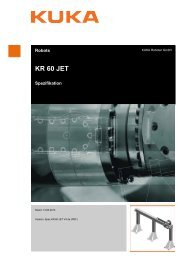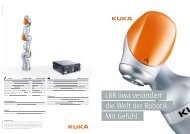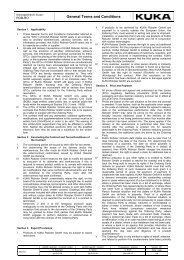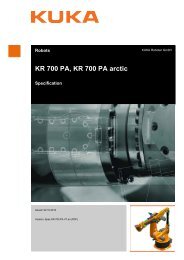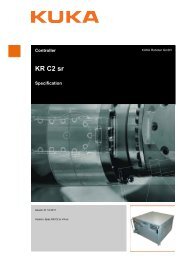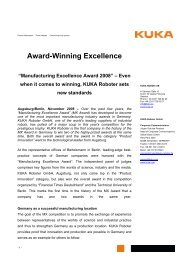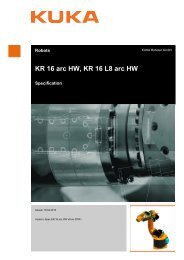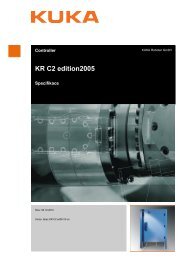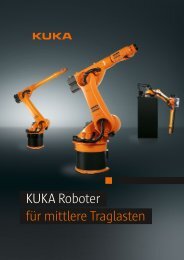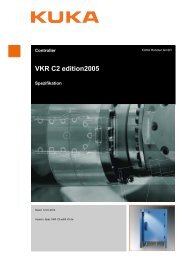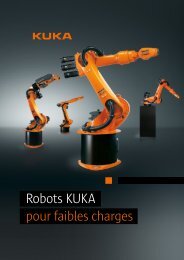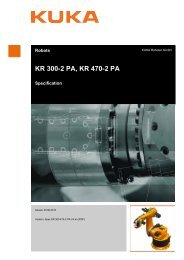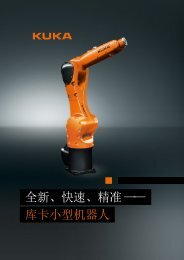KUKA Posiflex KPF1-MB Family - KUKA Robotics
KUKA Posiflex KPF1-MB Family - KUKA Robotics
KUKA Posiflex KPF1-MB Family - KUKA Robotics
Create successful ePaper yourself
Turn your PDF publications into a flip-book with our unique Google optimized e-Paper software.
3 Safety<br />
• Each person must have an enabling device.<br />
• All persons must have an unimpeded view of the industrial robot.<br />
• Eye-contact between all persons must be possible at all times.<br />
• The operator must be so positioned that he can see into the danger area<br />
and get out of harm’s way.<br />
In Manual High Velocity mode (T2):<br />
• This mode may only be used if the application requires a test at a velocity<br />
higher than Manual Reduced Velocity.<br />
• Teaching and programming are not permissible in this operating mode.<br />
• Before commencing the test, the operator must ensure that the enabling<br />
devices are operational.<br />
• The operator must be positioned outside the danger zone.<br />
• There must be no other persons inside the safeguarded area. It is the responsibility<br />
of the operator to ensure this.<br />
3.5.5 Automatic mode<br />
Automatic mode is only permissible in compliance with the following safety<br />
measures:<br />
• All safety equipment and safeguards are present and operational.<br />
• There are no persons in the system.<br />
• The defined working procedures are adhered to.<br />
If the manipulator or an external axis (optional) comes to a standstill for no apparent<br />
reason, the danger zone must not be entered until an EMERGENCY<br />
STOP has been triggered.<br />
3.5.6 Maintenance and repair<br />
After maintenance and repair work, checks must be carried out to ensure the<br />
required safety level. The valid national or regional work safety regulations<br />
must be observed for this check. The correct functioning of all safety circuits<br />
must also be tested.<br />
The purpose of maintenance and repair work is to ensure that the system is<br />
kept operational or, in the event of a fault, to return the system to an operational<br />
state. Repair work includes troubleshooting in addition to the actual repair<br />
itself.<br />
The following safety measures must be carried out when working on the<br />
industrial robot:<br />
• Carry out work outside the danger zone. If work inside the danger zone is<br />
necessary, the user must define additional safety measures to ensure the<br />
safe protection of personnel.<br />
• Switch off the industrial robot and secure it (e.g. with a padlock) to prevent<br />
it from being switched on again. If it is necessary to carry out work with the<br />
robot controller switched on, the user must define additional safety measures<br />
to ensure the safe protection of personnel.<br />
• If it is necessary to carry out work with the robot controller switched on, this<br />
may only be done in operating mode T1.<br />
• Label the system with a sign indicating that work is in progress. This sign<br />
must remain in place, even during temporary interruptions to the work.<br />
• The EMERGENCY STOP systems must remain active. If safety functions<br />
or safeguards are deactivated during maintenance or repair work, they<br />
must be reactivated immediately after the work is completed.<br />
Issued: 11.08.2010 Version: Spez <strong>Posiflex</strong> <strong>KPF1</strong>-<strong>MB</strong> Familie V3 en<br />
25 / 55



